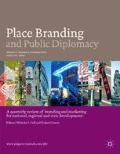Abstract
This article draws attention to storytelling in public diplomacy. Based on interviews with officials in the European External Action Service (EEAS) and a campaign on social media, it explores storytelling in EU public diplomacy. It treats storytelling as narrative strategies that tap into the power of dramaturgy and visual elements to mediate emotions and identity in international politics. This understanding of storytelling is discussed in relation to three interrelated bodies of literature of relevance to the digitalization of public diplomacy. The study traces how storytelling in the EEAS stems from the norm of engagement, intends for a process of legitimation through techniques of representation, and has the goal of recognition. The analysis illustrates the conceptualization of storytelling focusing on the communication of the European Union’s Global Strategy launched in June 2016. The article finds the role of storytelling to be a result of the perceived new urgency of engaging domestic publics in EU foreign policy. In this context the role of stories to evoke emotions and the opportunities on social media to project these stories, are highly valued.
Similar content being viewed by others
References
Ahmed, S. 2014. Conclusion: Just Emotions. In The Cultural Politics of Emotion, 191–203. Edinburgh: Edinburgh University Press.
Adler-Nissen, R., and A. Tsinovoi. 2018. International Misrecognition: The Politics of Humor and National Identity in Israel’s Public Diplomacy. European Journal of International Relations 25 (1): 3–29.
Bjola, C., and M. Holmes (eds.). 2015. Digital Diplomacy: Theory and Practice. London: Routledge.
Bjola, C., and J. Pamment. 2016. Digital Containment: Revisiting Containment Strategy in the Digital Age. Global Affairs 2 (2): 131–142.
Bleiker, R. 2001. The Aesthetic Turn in International Political Theory. Millennium: Journal of International Studies 30 (3): 509–533.
Browning, C.S. 2018. Brexit, Existential Anxiety and Ontological (In)Security. European Security 27 (3): 336–355.
Bruner, J. 1986. Actual Minds, Possible Worlds. Cambridge, MA: Harvard University Press.
Callahan, A.W. 2015. The Visual Turn in IR: Documentary Filmmaking as a Critical Method. Millennium 43 (3): 891–910.
Constantinou, C. 2018. Visual Diplomacy: Reflections on Diplomatic Spectacle and Cinematic Thinking. The Hague Journal of Diplomacy 13 (4): 1–23.
Cooper, A.F. 2019. Adapting Public Diplomacy to the Populist Challenge. The Hague Journal of Diplomacy 14 (1–2): 36–50.
Cull, N. 2019. Public Diplomacy. Foundations for Global Engagement in the Digital Age. Cambridge: Polity Press.
Davis Cross, M.K. 2015. The Public Diplomacy Role of the EEAS: Crafting a Resilient Image for Europe. In The European External Action Service European Diplomacy Post-Westphalia, ed. D. Spence and J. Bátora. Basingstoke: Palgrave Macmillan.
Duncombe, C. 2016. Representation, Recognition and Foreign Policy in the Iran-US Relationship. European Journal of International Relations 22 (3): 642–655.
Duncombe, C. 2019. Digital Diplomacy: Emotion and Identity in the Public Realm. The Hague Journal of Diplomacy 14 (1–2): 102–116.
EEAS. 2016. Shared Vision, Common Action: A Stronger Europe. A Global Strategy for the European Union’s Foreign and Security Policy. http://europa.eu/globalstrategy/en/global-strategy-foreign-and-security-policy-european-union. Accessed 20 Nov 2018.
EEAS. 2017. The European Way. https://eeas.europa.eu/headquarters/headquarters-homepage/search/site_en?f%5B0%5D=im_field_tags%3A899. Accessed 20 Nov 2018.
Fan, Y. 2010. Branding the Nation: Towards a Better Understanding. Place Branding and Public Diplomacy 6 (2): 97–103.
Gabriel, Y. 2004. The Narrative Veil: Truth and Untruths in Storytelling. In Myths, Stories and Organizations: Premodern Narratives for Our Times, ed. Y. Gabriel. Oxford: Oxford University Press.
Graham, S.E. 2014. Emotion and Public Diplomacy: Dispositions in International Communications. Dialogue and Persuasion. International Studies Review 16 (4): 522–539.
Hansen, L. 2017. Reading Comics for the Field of International Relations: Theory, Method and the Bosnian War. European Journal of International Relations 23 (3): 581–608.
Hedling, E. 2018. Blending Politics and New Media: Practices of EU Digital Diplomacy. PhD. Lund: Lund University.
Huijgh, E. 2013. Changing Tunes for Public Diplomacy: Exploring the Domestic Dimension. Exchange: The Journal of Public Diplomacy 2 (1): 62–73.
Hutchison, E. 2016. Affective Communities in World Politics: Collective Emotions After Trauma. Cambridge: Cambridge University Press.
Kampf, R., I. Manor, and E. Segev. 2015. Digital Diplomacy 2.0? A Cross-national Comparison of Public Engagement in Facebook and Twitter. The Hague Journal of Diplomacy 10 (4): 331–365.
la Cour, C. 2018. The Evolution of the ‘Public’ in Diplomacy. Place Branding and Public Diplomacy 14 (1): 22–35.
Lindemann, T., and E. Ringmar (eds.). 2012. The International Politics of Recognition. Boulder, CO: Paradigm.
Lundby, K. 2008. Digital Storytelling, Mediatized Stories. Bern: Peter Lang Publishing.
McAllister, I. 2007. The Personalization of Politics. In Oxford Handbook of Political Behavior, ed. R. Dalton and H.-D. Klingemann. Oxford: Oxford University Press.
Melissen, J. 2005. The New Public Diplomacy: Soft Power in International Relations. Basingstoke: Palgrave Macmillan.
Miskimmon, A., B. O’Loughlin, and L. Roselle. 2013. Strategic Narratives Communication Power and the New World Order. New York: Routledge.
Nel, P. 2010. Redistribution and Recognition: What Emerging Regional Powers Want. Review of International Studies 36 (4): 951–974.
Ördén, H. 2017. Deferring Substance: EU Policy and the Information Threat. Intelligence and National Security 34 (3): 421–437.
Pamment, J. 2014. Strategic Narratives in US Public Diplomacy: A Critical Geopolitics. Popular Communication 12 (1): 48–64.
Pisarska, K. 2016. The Domestic Dimension of Public Diplomacy. Evaluating Success Through Civil Engagement. Basingstoke: Palgrave Macmillan.
Pulizzi, J. 2012. The Rise of Storytelling as the New Marketing. Publishing Research Quarterly 28 (2): 116–123.
Robertson, J. 2018. The ‘Stock Market of Diplomatic Reputation’: Reputation on Diplomacy’s Frontline. The Hague Journal of Diplomacy 13 (3): 366–385.
Shapiro, M.J. 2013. Studies in Trans-Disciplinary Method: After the Aesthetic Turn. New York: Routledge.
Author information
Authors and Affiliations
Corresponding author
Additional information
Publisher's Note
Springer Nature remains neutral with regard to jurisdictional claims in published maps and institutional affiliations.
Electronic supplementary material
Below is the link to the electronic supplementary material.
Rights and permissions
About this article
Cite this article
Hedling, E. Storytelling in EU public diplomacy: reputation management and recognition of success. Place Brand Public Dipl 16, 143–152 (2020). https://doi.org/10.1057/s41254-019-00138-2
Revised:
Published:
Issue Date:
DOI: https://doi.org/10.1057/s41254-019-00138-2




